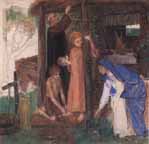In comparison with other works we have examined, Dante Gabriel Rossetti's The Passover in the Holy Family represents both a new approach to typological symbolism and a new way of inscribing a textual narrative onto a painting. The watercolor shows the Holy Family preparing for the Passover holiday: Mary gathers bitter herbs, one of the traditional components of the Seder plate, while Zachary paints the door and lintel of the house with lamb's blood as prescribed by the Book of Exodus. Jesus holds the bowl of lamb's blood as John the Baptist ties Jesus's shoes. All these actions are invested with typological symbolism. For example, the lamb's blood symbolizes the blood that Christ, the Lamb (with capital L), will later shed on the cross, whereas the bitter herbs perhaps echo the bitterness of Christ's sacrifice. However, Rossetti does not simply present these images and allow the viewer to decipher their symbolic meaning. Rather, he accompanies the watercolor with a poem of the same title in which he explicates each of the symbols:

The pyre is piled. What agony's crown attained,
What shadow of Death the Boy's fair brow subdues
Who holds that blood wherewith the porch is stained
By Zachary the priest? John binds the shoes
He deemed himself not worthy to unloose;
And Mary culls the bitter herbs ordained.
The poem explicitly spells out the symbolism of the painting; for example, it states what John is doing and identifies the typological meaning of this action.
Questions
1. Many other Pre-Raphaelite paintings, such as Millais's Christ in the House of His Parents, did not include accompanying texts but referred to one or more textual narratives. In contrast, Rossetti's painting has an accompanying text which explains the narrative behind the painting. What are the advantages of Rossetti's method of textualization in comparison with that of Millais?
2. Does the painting make sense without the poem? Could an educated Victorian viewer understand the symbolism of The Passover in the Holy Family without reading the poem?
3. Does the poem make sense without the painting? Our edition of Rossetti: Collected Poetry and Prose reproduces the poem "The Passover in the Holy Family" but not the painting. Thus it includes a footnote describing what the painting looks like. Does this suggest that the poem can only be read within the context of the painting?
4. Hunt and Millais's paintings used a detailed and realistic style, partly so that their typological symbols could function both as symbols and as authentic-looking objects or persons. One can admire a painting like Christ in the House of His Parents both for its convincing surface-level realism and for its additional layers of symbolic meaning. By contrast, The Passover in the Holy Family looks two-dimensional and almost primitive. Does this painting's lack of realism detract from the effectiveness of its typological symbolism?
Related Materials
Last modified 27 June 2020